Performance-Based Transport Selection selects the VPN transport offering the best latency (Round Trip Time) or bandwidth for the traffic matching the access rule. Only UDP transports with Dynamic Bandwidth and Round Trip Time Detection are supported. Performance-Based Transport Selection can route traffic using the following policies:
Optimize for Latency
Optimize for Outbound Bandwidth
Optimize for Inbound Bandwidth
Optimize for Combined Bandwidth

Before You Begin
Create a multi-transport VPN tunnel between two CloudGen Firewalls:
Create a TINA site-to-site VPN tunnel. For more information, see How to Create a TINA VPN Tunnel between CloudGen Firewalls or How to Create a VPN Tunnel with the VPN GTI Editor.
Add one or more additional UDP transports to the VPN tunnel. For more information, see How to Add a VPN Transport to a TINA VPN Tunnel with Explicit Transport Selection or How to Configure SD-WAN Using the VPN GTI Editor.
Create access rules for each type of traffic going through the VPN tunnel. For more information, see How to Create Access Rules for Site-to-Site VPN Access.
(Consolidated Shaping only) Set the QoS Profile and enable shaping for the physical interfaces used by the VPN traffic.
Step 1. Enable Dynamic Bandwidth and Latency Detection for Each Transport
On both VPN endpoints, edit all transports to enable dynamic bandwidth- and round trip time detection.
Go to CONFIGURATION > Configuration Tree > Box > Assigned Services > VPN Service > Site-to-Site.
Click Lock.
Double-click the TINA VPN transport. The TINA Tunnel Transport window opens.
Click the SD-WAN - Bandwidth Protection tab.
From the Dynamic Bandwidth Detection list, select a policy:
Active Probing and Passive Monitoring
Active Probing Only
No Probing - use Estimated Bandwidth
(optional) From the Bandwidth Policy list, select Consolidated Shaping and select the Assigned QoS Profile. For more information, see TINA Tunnel Settings.
Enter the Estimated Bandwidth bandwidth.
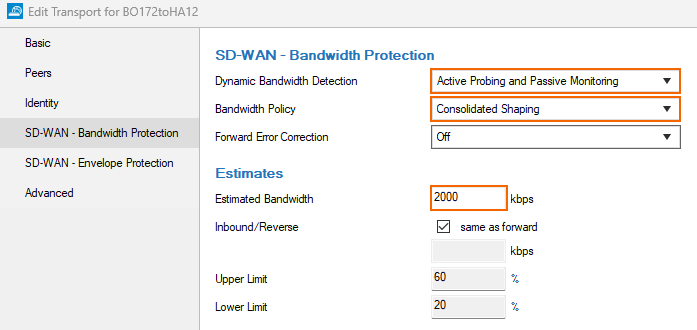
Click OK.
Click Send Changes and Activate.
After completing these changes, go to VPN > Site-to-Site. Right-click the transport and select Monitor Traffic. The Round Trip Time, drop rate, and traffic on the transport is now displayed in real time.
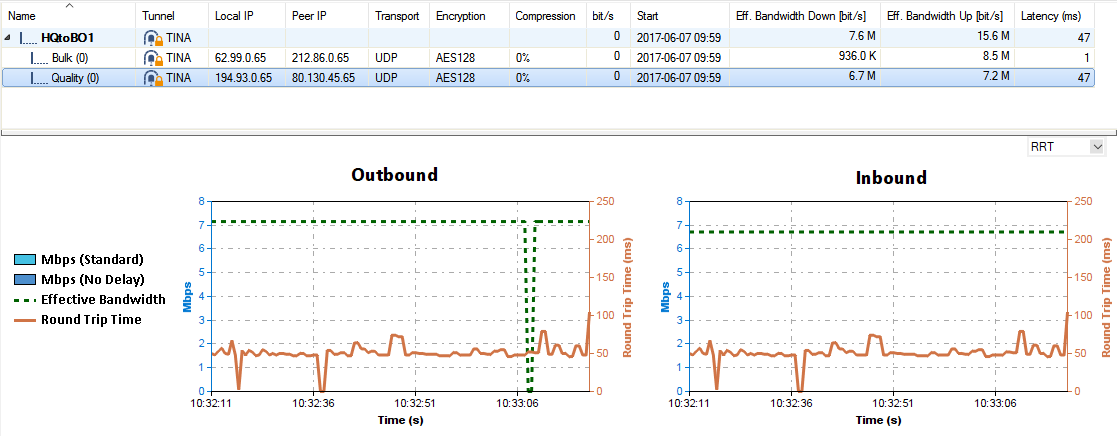
Step 2. Create a Custom Connection Object for the SD-WAN Primary
Go to CONFIGURATION > Configuration Tree > Box > Assigned Services > Firewall > Forwarding Rules.
In the left menu, click Connections.
Right-click the table and select New Connection. The Edit/Create a Connection Object window opens.
In the Name field, enter a name for the connection object.
From the Translated Source IP list, select Original Source IP.
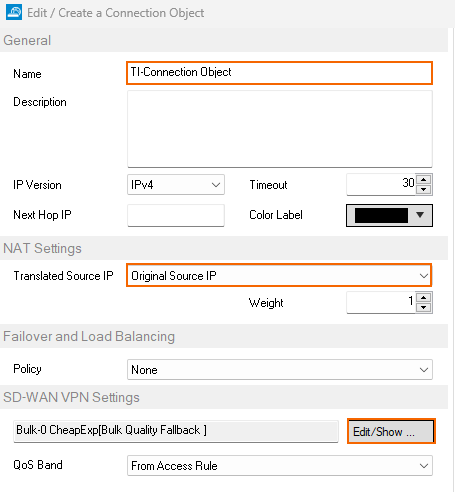
To edit the VPN SD-WAN settings, click Edit/Show. The SD-WAN Settings window opens.
Configure the Transport Policies:
Transport Selection Policy – Select the criteria to optimize for:
Optimize for Inbound Bandwidth
Optimize for Outbound Bandwidth
Optimize for Combined Bandwidth
Optimize for Latency
SD-WAN Learning Policy – Select Primary.

Configure the Explicit Transport Selection as the fallback if no more transports with Dynamic Bandwidth and Round Trip Time Detection are available.
Primary Transport Class – Select the primary transport class.
Primary Transport Priority/ID – Select the ID for the primary transport.
Secondary Transport Class – Select the secondary transport class.
Secondary Transport Priority/ID – Select the ID for the secondary transport.
Feature Level 8.x, >=9.0.4 | Feature Level 9.0 through 9.0.3 |
|---|---|
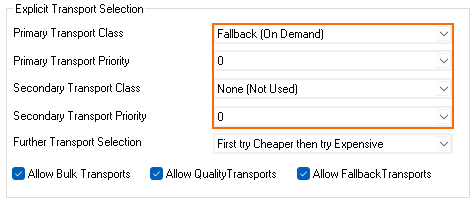 |  |
Click OK.
Click Send Changes and Activate.
Step 3. Create a Custom Connection Object for the SD-WAN Secondary
Go to CONFIGURATION > Configuration Tree > Box > Assigned Services > Firewall > Forwarding Rules.
In the left menu, click Connections.
Right-click the table and select New Connection. The Edit/Create a Connection Object window opens.
Enter a Name.
From the Translated Source IP list, select Original Source IP.
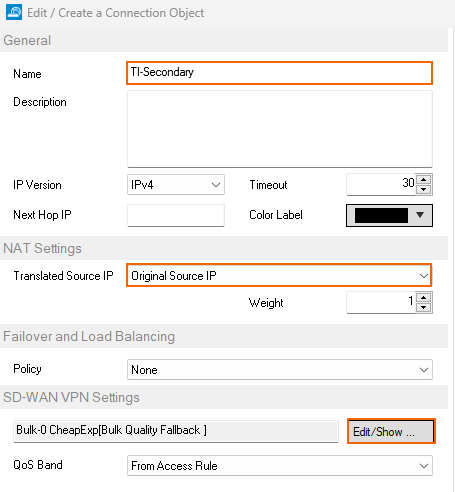
To edit the VPN SD-WAN settings, click Edit/Show. The SD-WAN Settings window opens.
From the SD-WAN Learning Policy drop-down list, select Secondary.
Feature Level 8 | Feature Level 9 |
|---|---|
 |  |
Click Ok.
Click Send Changes and Activate.
Step 4. Modify Access Rule on the Firewall Acting as SD-WAN Primary
Go to CONFIGURATION > Configuration Tree > Box > Assigned Services > Firewall > Forwarding Rules.
Click Lock.
Right-click the ruleset and select New > Rule to create an access rule to match the VPN traffic you want to balance:
Action – Select Pass.
Bi-Directional – Select the check box to apply the rule in both directions.
Source – Select a network object for all local networks.
Service– Select a service object from the list.
Destination – Select the network object containing the remote networks.
Connection Method – Select the connection object for the SD-WAN primary created in step 2.
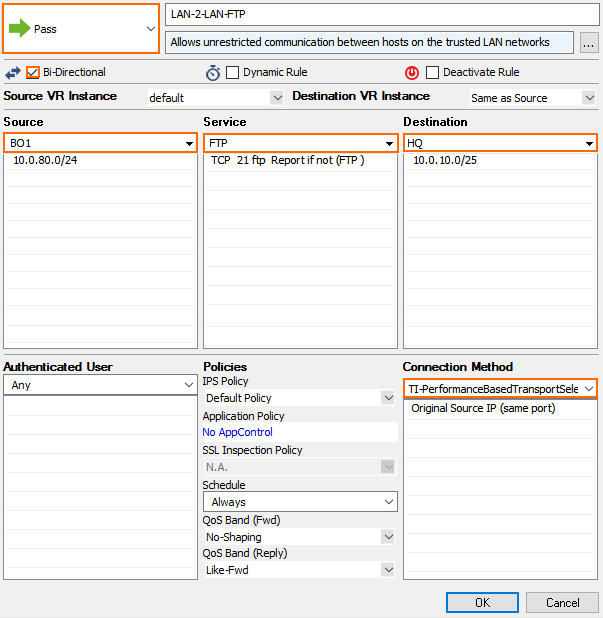
Click OK.
Click Send Changes and Activate.
Step 5. Modify Access Rule on the Firewall Acting as SD-WAN Secondary
Go to CONFIGURATION > Configuration Tree > Box > Assigned Services > Firewall > Forwarding Rules.
Click Lock.
Right-click the ruleset and select New > Rule to create an access rule to match the VPN traffic you want to balance:
Action – Select Pass.
Bi-Directional – Select the check box to apply the rule in both directions.
Source – Select a network object for all local networks.
Service– Select a service object from the list.
Destination – Select the network object containing the remote networks.
Connection Method – Select the connection object for the SD-WAN secondary created in step 3.
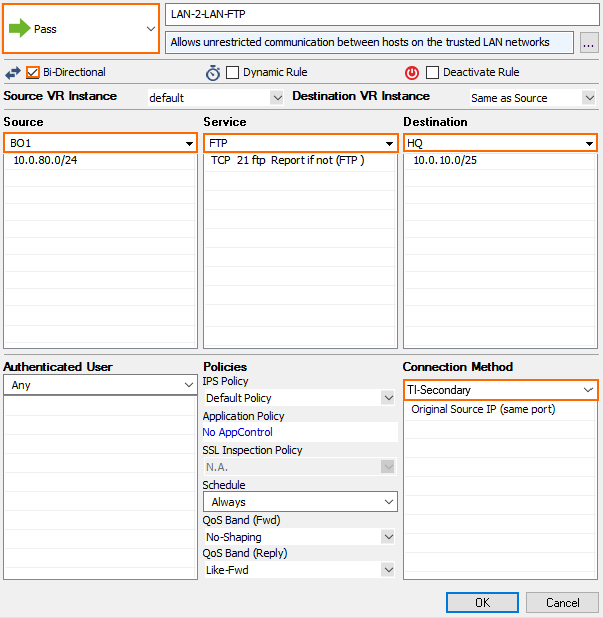
Click OK.
Click Send Changes and Activate.
Traffic matching the access rule is now balanced according to the performance criteria selected in the SD-WAN settings of the connection object in the matching access rule. To find out which transport has the best bandwidth or Round Trip Time, go to the VPN > Site-to-Site page and compare the values in the Eff Bandwidth Down, Eff Bandwidth Up, or Latency columns for all transports configured in the connection object. Go to the FIREWALL > Live page and, in the SD-WAN column of the traffic matching the access rule with the Performance-Based Transport Selection connection object, verify that the best transport is used. In this case, the Q0 transport is the primary transport, but the B0 transport offers the better bandwidth. Therefore, according to the Best Combined Bandwidth policy, traffic is sent through the B0 transport.


Next Steps
Combine Performance-Based Transport Selection with Adaptive Bandwidth Protection.
For more information, see How to Configure Dynamic Bandwidth Protection for VPN Tunnels with SD-WAN.
